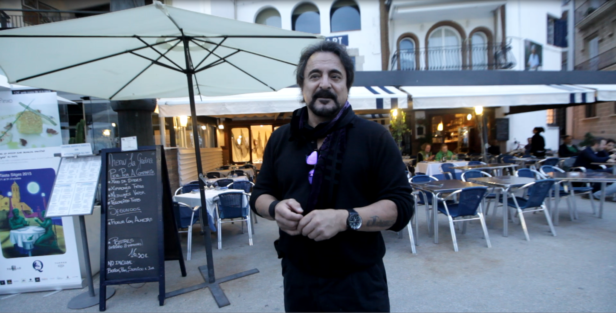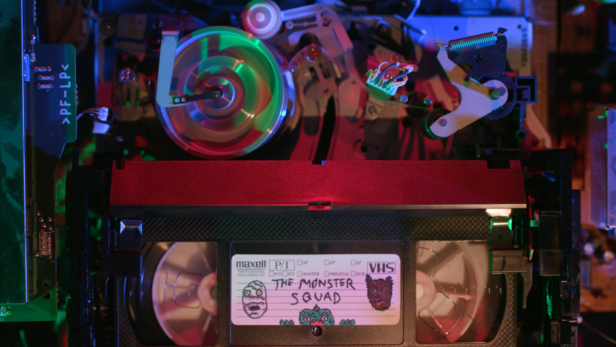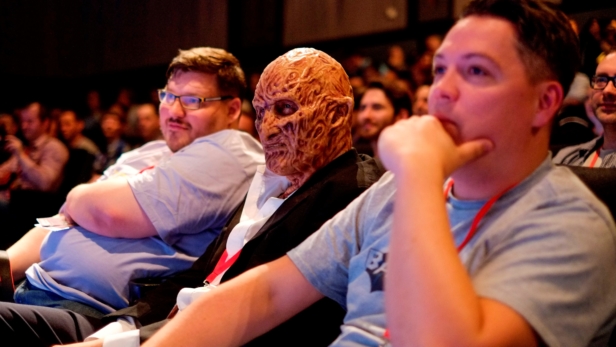This year’s FrightFest features three documentaries that hold up a mirror to the festival audience. For Cult Of Terror, Wolfman’s Got Nards and FrightFest: Beneath The Dark Heart Of Cinema all show that strange, intimate and weirdly obsessive connection that horror fans have to the films that feed their insatiable hunger for cathartic thrills and cushioned confrontations with their own mortality and the terrifying unknown.
Cult Of Terror (Culto al Terror)
Many years in the making, Gustavo Mendoza’s Cult Of Terror (Culto al Terror) is a festival-hopping exploration of the genre and its audience, taking full advantage of the many filmmaking talents, programmers, critics, merchandisers and (of course) fans who congregate at specialist events around the world to celebrate together the object of their worship.
Mendoza himself is from Argentina, and so the film has a particular focus on Iberian and Iberian-American horror, with trips to Spain’s Sitges International Film Festival, Brazil’s Fantaspoa, Mexico’s Morbido land Argentina’s own Rojo Sangre (as well as a brief visit to FrightFest itself, which has recently been championing South American horror). Similarly, while subjects like Robert Englund, Barbara Crampton, Mick Garris, Peter Bogdanovich and FrightFest’s own Alan Jones will be more than familiar to English-speaking viewers, Mendoza gives at least as much prominence in his interviews to the (now deceased) writer/director/actor Paul Naschy, whose Mark Of The Werewolf (1968) kickstarted Spanish horror, and to José Mojica Marins, who did the same for Brazilian horror in the early Sixties with his ‘Coffin Joe’ films.
It’s a piecemeal affair, its scrappy nature underlined and punctuated by various encounters with Bruce Campbell at Q&As where the iconic Evil Dead star has to keep reminding Mendoza, only half jokingly, that he cannot be filmed without official clearance. The very inclusion of this footage suggests that permission was indeed eventually granted – and the amateurishness of Mendoza’s approach reveals in itself something essential about horror fandom, uniting a disparate group of individuals through their common, often near pathological passion for genre.
Cult Of Terror is not just a globe-trotting trawl of festivals and their peripheries (cosplay, etc.), but also a whistle-stop tour of the genre itself: its key films and icons, the primal urges early encounters that keep us watching, the safe space that it offers for confronting both everyday and existential anxieties. And there is something special about horror and its fanbase – for as various contributors point out, no other genre comes with as many associated fanzines, T-shirts or indeed dedicated festivals.
Wolfman’s Got Nards
Narrowing its focus to a single genre film, but then fanning out from that to broader questions of what constitutes a cult film and its audience, Wolfman’s Got Nards traces the evolution of Fred Dekker’s The Monster Squad : its conception and production, its flopping at the box office, its subsequent dissemination into young viewers’ unconscious through cable television and VHS in the late Eighties, and its resurrection in the Noughties as retrospective event cinema on the independent circuit (starting with the Alamo Drafthouse) and eventually on DVD. It was the very definition of a sleeper hit, initially mauled by critics and ignored by cinemagoers, with Dekker (who made his last feature, RoboCop 3, in 1993) not even realising until 2006 that anybody liked it. Many, many did.
Nostalgia is crucial here. Not only was The Monster Squad a ‘gateway drug’ to horror for kids (who readily identified with its Goonies-age ensemble of misfit characters), but the antagonists that these children must face in their rite of passage very obviously harked back to the ‘Universal monsters’ of horror’s Golden Age – and viewed now, The Monster Squad comes with its own in-built nostalgia for anyone who grew up with it. If you are one of those, then this documentary will be pure catnip, allowing you to indulge in that sense of cameraderie that you have always felt with the ‘squad’, as well as with the countless fans celebrated in this documentary who share your enthusiasm. Or if, like me, you have never been a great fan of the film, then the documentary still serves as an engaging socio-anthropological study of cultic behaviour.
Having André Gower (who played child protagonist Sean in the original film) at the helm no doubt helped guarantee the participation of so many of the cast and crew, including Dekker and his co-writer Shane Black (Lethal Weapon, Kiss Kiss Bang Bang, The Nice Guys), and seemingly the late Stan Winston’s entire make-up and effects personnel (all of whom had their careers made by The Monster Squad). The film follows the template established by Best Worst Movie, a documentary on Claudio Fragesso’s Troll 2 similarly directed by one of its subject’s child stars (Michael Stephenson), and similarly following the arc of box-office failure, disappearance, and surprise rebirth. The difference, though, is that Troll 2 is now received with affectionate irony as one of those so-bad-it’s-good titles best viewed in a hipster crowd – whereas the fanbase for The Monster Squad adores it with unironic sincerity and wonder, and has done so since childhood.
Wolfman’s Got Nards is definitely a love-in – and the many fans of The Monster Squad that it documents include people like Adam Green and Joe Lynch, who having seen and loved it as kids have gone on to become horror filmmakers (and FrightFest favourites) in their own right.
FrightFest: Beneath The Dark Heart Of Cinema
The self-regard peaks here. The only thing that would have made the experience of sitting among a FrightFest audience taking in a film about FrightFest and its audience (with many of those in the theatre also appearing on screen) even more reflexive would have been to replace the film with a giant mirror, tilted slightly downward so we could all just watch ourselves watching. Chris Collier’s documentary takes in the history of the festival and its organisers, beginning in a middle that was also a kind of end: the very last screening that the festival enjoyed at its most popular venue, the old Empire on Leicester Square, in 2012. From there it works back to the early days in the Prince Charles, and then through a series of venues that have dissipated and atomised the festival experience in a way that reflects the changing ways we watch films in general.
Along the way, there are extensive interviews with organisers Alan Jones, Paul McEvoy, Ian Rattray and Greg Day, as well as with various directors who have attended over the years, and many diehard fans – all to the accompaniment of a treasure trove of archival footage tracing the event’s thousand faces. Perhaps under the influence of Jones’ predilection for disco, FrightFest has long adopted the slogan “We are family”, and boasted of the friendly camaraderie and strong bonds that have developed between participants, many of whom organise their annual calendar around its different incarnations and regard each one as a big, happy, boozy reunion. Yet one of the paradoxes that emerges from the organisers’ often disarmingly candid contributions to this documentary is that they themselves, while brilliant programmers and coordinators, are by no means the best of friends (editor Craig Ennis’ cutaway during this section to Jones sporting an Attack Of The Adult Babies T-shirt is very sly). How ironic that the festival’s much-vaunted family atmosphere should be born, alchemically, out of so much dysfunction.
Perhaps that tension is the ultimate metaphor for the workings of horror – the genre where domestic contentment practically always conceals a dark heart. The big question, though, is whether films like this – marginalia even within their own often marginalised genre – can ever have any appeal to a wider audience. At FrightFest itself, however, it could not have been more at home.
Cult Of Terror, Wolfman’s Got Nards and FrightFest: Beneath The Dark Heart Of Cinema were seen and reviewed at Arrow Video FrightFest.


